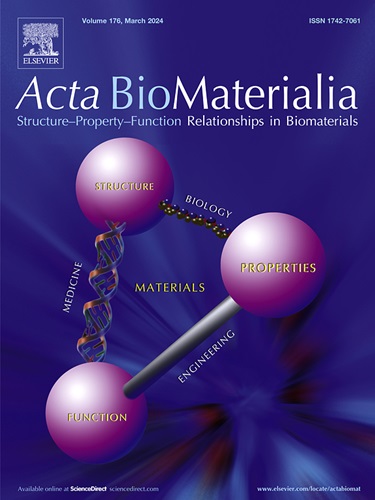预矿化和预血管化对人源组织工程骨结构成骨和血管整合的不同影响。
IF 9.4
1区 医学
Q1 ENGINEERING, BIOMEDICAL
引用次数: 0
摘要
成骨(骨形成)和血管形成(血管形成)是骨形成的两个核心和相互关联的生理相关过程。拟人化组织工程骨构建体(htebc)的预血管化已被提出,通过增强血管整合和促进更大的成骨能力来更好地模拟人骨微环境。在这里,我们使用支架-水凝胶复合方法研究了预矿化和预血管化对异位hTEBC模型骨和血管发育的影响。人成骨细胞(hOBs)在成骨条件(OM)下培养,在植入多孔聚己内酯(mPCL)支架之前,有或没有3天的矿化促进(OM+)期,持续4周。另外,在体外培养人脐静脉内皮细胞(HUVECs)和人骨髓间充质干细胞/基质细胞(MSCs)的情况下,放置在mPCL支架内的光交联鱼明胶衍生的水凝胶早在第3天就形成了细长的血管网络。将OM和OM+培养的构建体皮下植入有和没有血管前水凝胶的免疫功能受损大鼠,形成OM、OM+、OM/Vas和OM+/Vas四个亚组。我们的研究结果表明,OM+组在体内导致更快的骨诱导和增强的成骨分化,具有编织骨结构和活跃的重塑。相反,预血管化(OM/Vas组,OM+/Vas组)导致体内骨体积和密度降低,但促进了人内皮网络的发育和与宿主血管的成功吻合。我们的研究强调了预矿化和预血管化的独特贡献,其中预矿化对于骨骼的形成至关重要,而预血管化可以增强血管整合,这为推进动物宿主hTEBC模型的生理相关性提供了重要的见解。意义声明:本研究在大鼠身上证明了结合血管壁龛的人源化组织工程骨结构的发展。通过在支架-水凝胶复合材料中整合创新的预矿化和预血管化技术,我们发现预矿化加速骨形成,而预血管化促进内皮网络的形成和与宿主血管的整合。光交联、低刚度LunaGel™水凝胶在体外共培养中增强了微血管样结构的形成和内皮细胞的发芽。然而,通过在可生物降解的复合材料中结合成骨和血管线索,这项工作通过创建一个更准确地反映血管化和骨形成的分化和竞争性质的模型,推进了骨组织工程领域。该平台在研究骨血管相互作用方面具有广泛的适用性,并可能为改进再生治疗生物材料的设计提供策略。本文章由计算机程序翻译,如有差异,请以英文原文为准。

Divergent effects of premineralization and prevascularization on osteogenesis and vascular integration in humanized tissue engineered bone constructs
Osteogenesis (bone formation) and vascularization (blood vessel formation) are two central and interconnected physiological-relevant processes in bone formation. Prevascularization of humanized tissue-engineered bone constructs (hTEBCs) has been proposed to better mimic the human bone microenvironment by enhancing vascular integration and facilitating greater osteogenic capacity. Here, we investigated the effects of premineralization and prevascularization on bone and vasculature development in an ectopic hTEBC model using a scaffold-hydrogel composite approach. Human osteoblast cells (hOBs) were cultured under osteogenic conditions (OM), with or without a 3-day mineralization boost (OM+) period for 4 weeks prior to implantation in vivo in a supporting porous polycaprolactone (mPCL) scaffold. Separately, photocrosslinkable fish gelatin-derived hydrogels placed within supporting mPCL scaffolds showed formation of elongated vascular networks as early as day 3 with in vitro coculture of human umbilical vein endothelial cells (HUVECs) and human bone marrow mesenchymal stem/stromal cells (MSCs). The OM and OM+ cultured constructs were subcutaneously implanted into immunocompromised rats with and without the prevascular hydrogels, resulting in four subgroups: OM, OM+, OM/Vas, and OM+/Vas. Our results demonstrated that the OM+ group led to more rapid osteoinduction and enhanced osteogenic differentiation in vivo with woven bone structure and active remodeling. Conversely, prevascularization (OM/Vas, OM+/Vas groups) led to reduce in vivo bone volume and density but promoted the development of human endothelial networks and successful anastomosis with host vasculature. Our study highlights the distinct contributions of premineralization and prevascularization, where premineralization is critical for robust bone formation and prevascularization enhances vascular integration, providing important insights for advancing the physiological relevance of hTEBC models in animal hosts.
Statement of significance
This study demonstrates the development of humanized tissue engineered bone constructs incorporating a vascular niche using a rat. By integrating innovative premineralization and prevascularization techniques within scaffold-hydrogel composites, we show that premineralization accelerates bone formation, while prevascularization promotes endothelial network formation and integration with host vasculature. Photocrosslinkable, low-stiffness LunaGel™ hydrogels enhanced microcapillary-like structure formation and endothelial sprouting in in vitro co-culture. However, by combining osteogenic and vascular cues within a biodegradable composite, this work advances the bone tissue engineering field by creating a model that more accurately reflects the divergent and competing nature of vascularization and bone formation. This platform has broad applicability for studying bone-vascular interactions and may inform strategies to improve the design of biomaterials for regenerative therapies.
求助全文
通过发布文献求助,成功后即可免费获取论文全文。
去求助
来源期刊

Acta Biomaterialia
工程技术-材料科学:生物材料
CiteScore
16.80
自引率
3.10%
发文量
776
审稿时长
30 days
期刊介绍:
Acta Biomaterialia is a monthly peer-reviewed scientific journal published by Elsevier. The journal was established in January 2005. The editor-in-chief is W.R. Wagner (University of Pittsburgh). The journal covers research in biomaterials science, including the interrelationship of biomaterial structure and function from macroscale to nanoscale. Topical coverage includes biomedical and biocompatible materials.
 求助内容:
求助内容: 应助结果提醒方式:
应助结果提醒方式:


